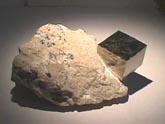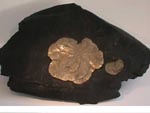
 Pyrite
PyriteSource: World wide
Chemical: FeS2 (Iron Sulfide)
Crystal System: Cubic
Formation: Igneous, metamorphic, sedimentary
Unusual Properties: Pyrite is an unusually fine example of the crystallization of iron. It can form perfect cubes as shown in the photograph above and in photo #3 below. These are natural cube shapes of this mineral, they have not been polished to look like this. Pyrite is also found on the top layer of a seam of coal in a coal mine. As shown in photo #1 below, as well as the pyrite sun that is seen in photo #2. These are flattened out forms of the cubic pyrite crystals. And in photo #4 you see a massive formation of very tiny pyrite crystals that form in these crystal globs. Pyrite can form in these clusters with very small crystals, or beautiful large crystal clusters that are used for ornamental purposes. Pyrite is sometimes referred to as fools gold due to its similar appearance to real gold in the field. More than one miner has started counting his fortune after striking it rich in a mining operation, only to find that he struck fools gold or pyrite rather than the gold he was looking for. And one interesting property about pyrite is that when struck by a metal object it will give off sparks, due to its high iron content. A point to remember if you find yourself in the woods without matches but with a handy pyrite cube in your pocket. Whether you are a student of gemology/mineralogy, or a collector who wants to add a special specimen to your collection, pyrite can serve as an excellent addition due to its perfect cube form.
